by Carrie Stevenson | Jan 14, 2021
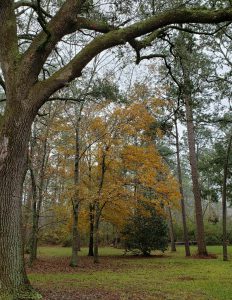
A healthy and diverse native forest provides many benefits for environmental and human health. Photo credit, Cathy Hardin
Trees often are low on priority lists – unless you had tree damage as a result of Hurricane Sally. However, you might be surprised to learn that trees played a beneficial, if somewhat behind the scenes, role for good this year and every year. And celebrating the good, while not ignoring potential problems, is important when making decisions involving trees.
Often trees are disparaged, especially after a severe storm. Many trees fell during Sally, causing costly clean up and often significant damage. Some trees were damaged: causing hazardous conditions, opportunities for the tree disease and insect infestation, or simply aesthetically unpleasant disfigurement. Even without storms, trees require care, can interfere with utilities and foundations, and require extra clean up certain times of year. Yet, healthy well-maintained trees might reduce wind speeds and damage for property underneath or on the leeward (downwind) side of trees. Trees also significantly reduce erosion and absorb stormwater.
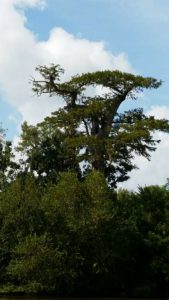
Bald cypress. Photo credit, Cathy Hardin
Trees often give more than they take. Many studies have been done on the effects of green space on a person’s well-being, including lowering blood pressure, speeding up recovery times, and lessening depression and anxiety. Other social benefits include lowering crime rates, increasing property values, creating beauty and space for recreation and relaxation, and lowering cooling bills. They provide habitat for birds and other wildlife. We haven’t even begun to mention the material benefits such as fruit, nuts, wood, and the 5,000 plus commercial products made from trees (wood, roots, leaves, and saps).
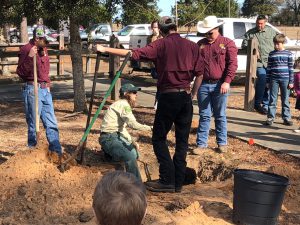
Author and county forester Cathy Hardin demonstrates proper tree planting at a past Arbor Day program. Photo credit: Carrie Stevenson, UF IFAS Extension
So, celebrate trees this year! Winter is a great time to improve existing trees and to plant new ones. Florida Arbor Day is celebrated the on the third Friday in January – January 15, 2021. National Arbor Day is the last Friday in April. In Escambia County, the UF IFAS Extension office is holding several Arbor Day related events, including a drive-through tree giveaway on January 23. Even if you are not able to attend a public event in your area, you still can get out and celebrate trees. Below are some ideas.
Existing Trees
• Care for storm damaged trees.
o Contact an arborist for evaluation of potential hazards
o Properly prune out broken limbs to create a smooth surface
o Some trees may not be able to be successfully treated and need removal
o Most trees will recover, but might need time and/or multiple treatments
• Learn about proper pruning techniques to take care of smaller trees yourself
• When hiring a professional is required, hire a reputable company with a certified arborist on staff. Ensure the company has both Personal and Property Damage Liability Insurance and Worker’s Compensation Insurance. Arborists certified by the International Society of Arboriculture can be found at http://www.isa-arbor.com/findanarborist/arboristsearch.aspx.
• Take care of tree roots. Don’t compact the soil by parking or piling things in the root zone. Use caution
when applying any chemicals (fertilizer, herbicide, pesticides) to the soil or lawn. Read the label to
ensure it will not harm your tree.
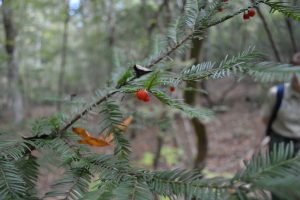
Florida yew. Photo credit, Cathy Hardin
New Plantings
• Decide what species of tree is right for you, considering the soil type, size of opening, climate, and eventual size of tree.
• Plant the tree at the right depth, not too deep or too shallow.
• Keep it simple. Soil amendments, fertilizers, and staking are usually unnecessary, especially for small native trees.
• Mulch lightly over the root zone, but not against the trunk.
• Water regularly until the tree is established. (Three gallons per inch of tree diameter weekly – applied slowly at the root ball)
• Celebrate!
• Take a photo of your favorite tree to post on social media. Tag the Florida Forest Service!
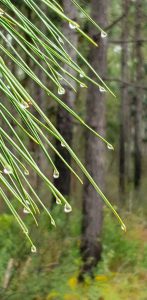
Longleaf pine. Photo credit, Cathy Hardin
• Take a hike in the woods or a nearby park.
• Have a picnic with friends or family by a tree.
• Be grateful for your tree and its benefits.
• Teach a child about trees. There are many activities that can be used. Check out Project Learning Tree Activities for Families – Project Learning Tree (plt.org) or the Arbor Day Foundation www.ArborDay.org for a few ideas.
• Plant a new tree.
For more information on the benefits of trees, visit healthytreeshealthylives.org or www.vibrantcitieslab.com. The Florida Forest Service, a division of the Florida Department of Agriculture and Consumer Services, manages more than 1 million acres of state forests and provides forest management assistance on more than 17 million acres of private and community forests. The Florida Forest Service is also responsible for protecting homes, forestland and natural resources from the devastating effects wildfire on more than 26 million acres. Learn more at FDACS.gov/FLForestService.
Cathy Hardin is the Escambia County Forester for the Florida Forest Service and can be reached at Cathy.Hardin@fdacs.gov.
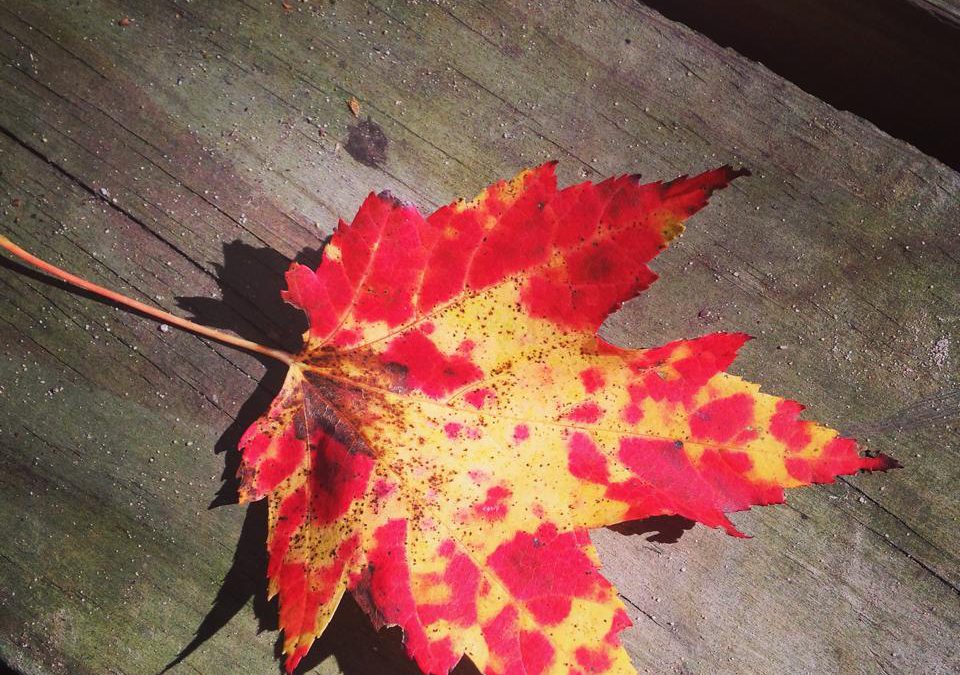
by Carrie Stevenson | Nov 18, 2020
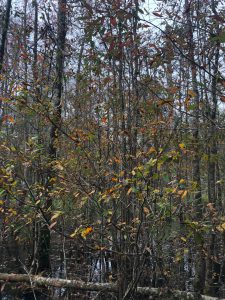
A blackgum/tupelo tree begins changing colors in early fall. Photo credit: Carrie Stevenson, UF IFAS Extension
It’s autumn and images of red, brown, and yellow leaves falling on the forest floor near orange pumpkins enter our minds. However, Florida isn’t necessarily known for its vibrant fall foliage, but if you know where to look this time of year, you can find some amazing scenery. In late fall, the river swamps can yield beautiful fall leaf color. The shades are unique to species, too, so if you like learning to identify trees this is one of the best times of the year for it. Many of our riparian (river floodplain) areas are dominated by a handful of tree species that thrive in the moist soil of wetlands. Along freshwater creeks and rivers, these tend to be bald cypress, blackgum/tupelo, and red maple. Sweet bay magnolia (Magnolia virginiana) is also common, but its leaves stay green, with a silver-gray underside visible in the wind.
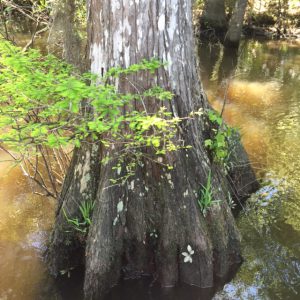
The classic “swamp tree” shape of a cypress tree is due to its buttressed trunk, an adaptation to living in wet soils. Photo credit: Carrie Stevenson, UF IFAS Extension
Bald cypress (Taxodium distichum) is one of the rare conifers that loses its leaves. In the fall, cypress tress will turn a bright rust color, dropping all their needles and leaving a skeletal, upright trunk. Blackgum/tupelo (Nyssa sylvatica) trees have nondescript, almost oval shaped leaves that will turn yellow, orange, red, and even deep purple, then slowly drop to the swamp floor. Blackgums and cypress trees share a characteristic adaptation to living in and near the water—wide, buttressed trunks. This classic “swamp” shape is a way for the trees to stabilize in the mucky, wet soil and moving water. Cypresses have the additional root support of “knees,” structures that grow from the roots and above the water to pull in oxygen and provide even more support.
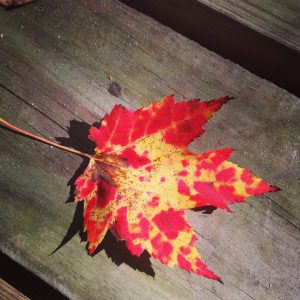
A red maple leaf displaying its incredible fall colors. Photo credit: Carrie Stevenson, UF IFAS Extension
The queen of native Florida fall foliage, however, is the red maple (Acer rubrum) . Recognizable by its palm-shaped leaves and bright red stem in the growing season, its fall color is remarkable. A blazing bright red, sometimes fading to pink, orange, or streaked yellow, these trees can jump out of the landscape from miles away. A common tree throughout the Appalachian mount range, it thrives in the wetter soils of Florida swamps.
To see these colors, there are numerous beautiful hiking, paddling, and camping locations nearby, particularly throughout Blackwater State Forest and the recreation areas of Eglin Air Force Base. But even if you’re not a hiker, the next time you drive across a bridge spanning a local creek or river, look downstream. I guarantee you’ll be able to see these three tree species in all their fall glory.
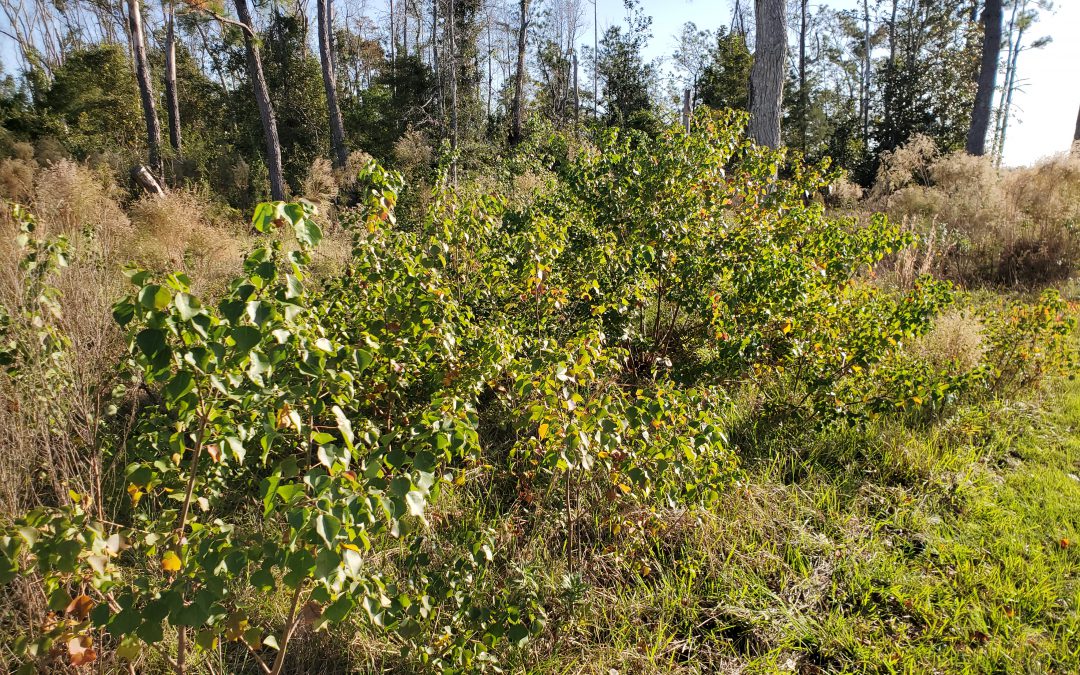
by Daniel J. Leonard | Nov 18, 2020
The native Florida landscape definitely isn’t known for its fall foliage. But as you might have noticed, there is one species that reliably turns shades of red, orange, yellow and sometimes purple, it also unfortunately happens to be one of the most significant pest plant species in North America, the highly invasive Chinese Tallow or Popcorn Tree (Triadica sebifera).
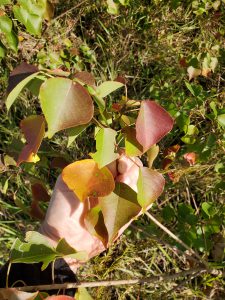
Chinese Tallow fall foliage. Photo courtesy of Daniel Leonard.
Native to temperate areas of China and introduced into the United States by Benjamin Franklin (yes, the Founding Father!) in 1776 for its seed oil potential and outstanding ornamental attributes, Chinese Tallow is indeed a pretty tree, possessing a tame smallish stature, attractive bark, excellent fall color and interesting white “popcorn” seeds. In addition, Chinese Tallow’s climate preferences make it right at home in the Panhandle and throughout the Southeast. It requires no fertilizer, is both drought and inundation tolerant, is both sun and shade tolerant, has no serious pests, produce seed preferred by wildlife (birds mostly) and is easy to propagate from seed (a mature
Chinese Tallow tree can produce up to 100,000 seeds annually!). While these characteristics indeed make it an awesome landscape plant and explain it being passed around by early American colonists, they are also the very reasons that make the species is one of the most dangerous invasives – it can take over any site, anywhere.
While Chinese Tallow can become established almost anywhere, it prefers wet, swampy areas and waste sites. In both settings, the species’ special adaptations allow it a competitive advantage over native species and enable it to eventually choke the native species out altogether.
In low-lying wetlands, Chinese Tallow’s ability to thrive in both extreme wet and droughty conditions enable it to grow more quickly than the native species that tend to flourish in either one period or the other. In river swamps, cypress domes and other hardwood dominated areas, Chinese Tallow’s unique ability to easily grow in the densely shaded understory allows it to reach into the canopy and establish a foothold where other native hardwoods cannot. It is not uncommon anymore to venture into mature swamps and cypress domes and see hundreds or thousands of Chinese Tallow seedlings taking over the forest understory and encroaching on larger native tree species. Finally, in waste areas, i.e. areas that have been recently harvested of trees, where a building used to be, or even an abandoned field, Chinese Tallow, with its quick germinating, precocious nature, rapidly takes over and then spreads into adjacent woodlots and natural areas.
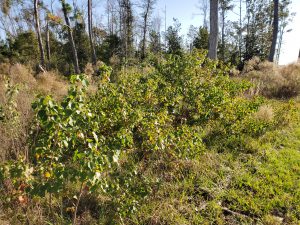
Chinese tallow seedlings colonizing a “waste” area. Photo courtesy of Daniel Leonard.
Hopefully, we’ve established that Chinese Tallow is a species that you don’t want on your property and has no place in either landscapes or natural areas. The question now is, how does one control Chinese Tallow?
- Prevention is obviously the first option. NEVER purposely plant Chinese Tallow and do not distribute the seed, even as decorations, as they are sometimes used.
- The second method is physical removal. Many folks don’t have a Chinese Tallow in their yard, but either their neighbors do, or the natural area next door does. In this situation, about the best one can do is continually pull up the seedlings once they sprout. If a larger specimen in present, cut it down as close to the ground as possible. This will make herbicide application and/or mowing easier.
- The best option in many cases is use of chemical herbicides. Both foliar (spraying green foliage on smaller saplings) and basal bark applications (applying a herbicide/oil mixture all the way around the bottom 15” of the trunk. Useful on larger trees or saplings in areas where it isn’t feasible to spray leaves) are effective. I’ve had good experiences with both methods. For small trees, foliar applications are highly effective and easy. But, if the tree is taller than an average person, use the basal bark method. It is also very effective and much less likely to have negative consequences like off-target herbicide drift and applicator exposure. Finally, when browsing the herbicide aisle garden centers and farm stores, look for products containing the active ingredient Triclopyr, the main chemical in brands like Garlon, Brushtox, and other “brush/tree & stump killers”. Mix at label rates for control.
Despite its attractiveness, Chinese Tallow is an insidious invader that has no place in either landscapes or natural areas. But with a little persistence and a quality control plan, you can rid your property of Chinese Tallow! For more information about invasive plant management and other agricultural topics, please contact your local UF/IFAS Extension office!
References:
Langeland, K.A, and S. F. Enloe. 2018. Natural Area Weeds: Chinese Tallow (Sapium sebiferum L.). Publication #SS-AGR-45. Printer friendly PDF version: https://edis.ifas.ufl.edu/pdffiles/AG/AG14800.pdf
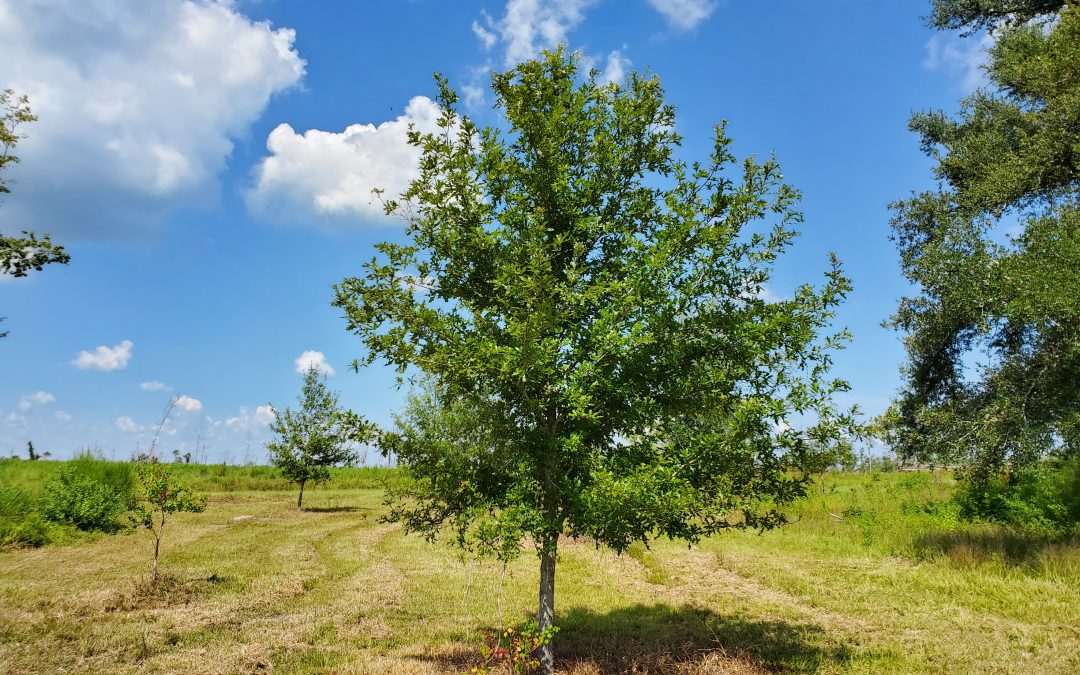
by Daniel J. Leonard | Sep 3, 2020
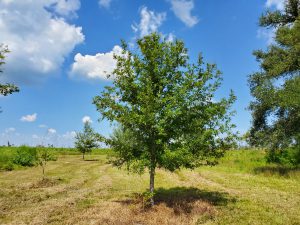
Overcup on the edge of a wet weather pond in Calhoun County. Photo courtesy of Daniel Leonard.
Haunting alluvial river bottoms and creek beds across the Deep South, is a highly unusual oak species, Overcup Oak (Quercus lyrata). Unlike nearly any other oak, and most sane people, Overcups occur deep in alluvial swamps and spend most of their lives with their feet wet. Though the species hides out along water’s edge in secluded swamps, it has nevertheless been discovered by the horticultural industry and is becoming one of the favorite species of landscape designers and nurserymen around the South. The reasons for Overcup’s rise are numerous, let’s dive into them.
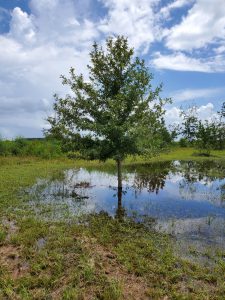
The same Overcup Oak thriving under inundation conditions 2 weeks after a heavy rain. Photo courtesy Daniel Leonard.
First, much of the deep South, especially in the Coastal Plain, is dominated by poorly drained flatwoods soils cut through by river systems and dotted with cypress and blackgum ponds. These conditions call for landscape plants that can handle hot, humid air, excess rainfall, and even periodic inundation (standing water). It stands to reason our best tree options for these areas, Sycamore, Bald Cypress, Red Maple, and others, occur naturally in swamps that mimic these conditions. Overcup Oak is one of these hardy species. It goes above and beyond being able to handle a squishy lawn, and is often found inundated for weeks at a time by more than 20’ of water during the spring floods our river systems experience. The species has even developed an interested adaptation to allow populations to thrive in flooded seasons. Their acorns, preferred food of many waterfowl, are almost totally covered by a buoyant acorn cap, allowing seeds to float downstream until they hit dry land, thus ensuring the species survives and spreads. While it will not survive perpetual inundation like Cypress and Blackgum, if you have a periodically damp area in your lawn where other species struggle, Overcup will shine.
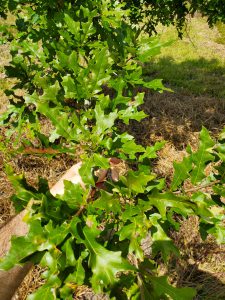
Overcup Oak leaves in August. Note the characteristic “lyre” shape. Photo courtesy Daniel Leonard.
Overcup Oak is also an exceedingly attractive tree. In youth, the species is extremely uniform, with a straight, stout trunk and rounded “lollipop” canopy. This regular habit is maintained into adulthood, where it becomes a stately tree with a distinctly upturned branching habit, lending itself well to mowers and other traffic underneath without having to worry about hitting low-hanging branches. The large, lustrous green leaves are lyre-shaped if you use your imagination (hence the name, Quercus lyrata) and turn a not-unattractive yellowish brown in fall. Overcups especially shine in the winter when the whitish gray shaggy bark takes center stage. The bark is very reminiscent of White Oak or Shagbark Hickory and is exceedingly pretty relative to other landscape trees that can be successfully grown here.
Finally, Overcup Oak is among the easiest to grow landscape trees. We have already discussed its ability to tolerate wet soils and our blazing heat and humidity, but Overcups can also tolerate periodic drought, partial shade, and nearly any soil pH. They are long-lived trees and have no known serious pest or disease problems. They transplant easily from standard nursery containers or dug from a field (if it’s a larger specimen), making establishment in the landscape an easy task. In the establishment phase, defined as the first year or two after transplanting, young transplanted Overcups require only a weekly rain or irrigation event of around 1” (wetter areas may not require any supplemental irrigation) and bi-annual applications of a general purpose fertilizer, 10-10-10 or similar. After that, they are generally on their own without any help!
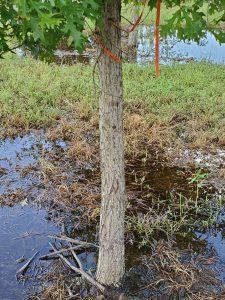
Typical shaggy bark on 7 year old Overcup Oak. Photo courtesy Daniel Leonard.
If you’ve been looking for an attractive, low-maintenance tree for a pond bank or just generally wet area in your lawn or property, Overcup Oak might be your answer. For more information on Overcup Oak, other landscape trees and native plants, give your local UF/IFAS County Extension office a call!
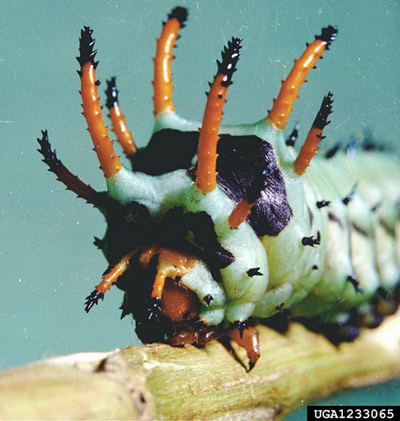
by Sheila Dunning | Jul 16, 2020
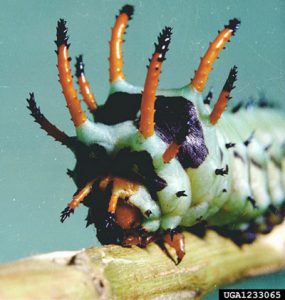
Credits: Clemson University, www.insectimages.org
The hickory horned devil is a blue-green colored caterpillar, about the size of a large hot dog, covered in long black thorns. They are often seen feeding on the leaves of deciduous forest trees, such as hickory, pecan, sweetgum, sumac and persimmon. For about 35 days, the hickory horned devil continuously eats, getting bigger and bigger every day. In late July to mid-August, they crawl down to the ground to search for a suitable location to burrow into the soil for pupation. While the hickory horned devil is fierce-looking, they are completely harmless. If you see one wandering through the grass or across the pavement, help it out by moving it to an open soil surface.
The pupa will overwinter until next May to early-June, at which time, they completely metamorphosize into a regal moth (Citheronia regalis). Like most other moths, it is nocturnal. But, this is a very large gray-green moth with orange wings, measuring up to 6 inches in width. It lives only about one week and never get to eat. In fact, they don’t even have a functional mouth. Adults mate during the second evening after emergence from the ground and begin laying eggs on tree leaves at dusk of the third evening. The adult moth dies of exhaustion. Eggs hatch in six to 10 days.
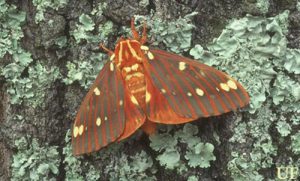
Adult regal moth, Citheronia regalis (Fabricius).Credits: Donald W. Hall, UF/IFAS
The regal moth, and its larvae stage called the hickory horned devil, is native to the southeastern United States. The damage they do to trees in minimal. Learning to appreciate this “odd” creature is something we can all do. For more information: https://edis.ifas.ufl.edu/pdffiles/IN/IN20900.pdf

by Carrie Stevenson | Jan 17, 2020
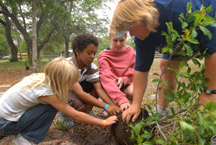
4H youth assist an IFAS Extension agent in planting a tree. UF/IFAS Photo: Josh Wickham.
This week, we celebrate Florida’s Arbor Day. “What?” you may say—“Isn’t Arbor Day in the spring?” Well, yes and no. National Arbor Day is celebrated in the spring (April 24 this year), usually within a day or two of Earth Day. However, because of the wide range of climatic environments throughout the United States, each state has its own date based on ideal growing conditions. As it stands, Florida’s is the 3rd Friday in January, as we are situated so very far south. Alabama and Georgia, where so many of us north Floridians experience similar weather, hold their Arbor Days in late February.
Contrary to popular opinion, the optimal planting time for trees in not in the spring, but in fall and winter. Planting during dormancy allows trees to focus their energy resources on growing healthy roots. In the coming spread, a steady supply of warmth, sunshine, and pollinators bring on leaf growth, flowers, and fruit.
Check with your local Extension offices, garden clubs, and municipalities to find out if there is an Arbor Day event near you! Several local agencies have joined forces to organize tree giveaway and sales events in observance of Florida’s Arbor Day.
Friday, January 17th
Okaloosa County: UF/IFAS Okaloosa County, in partnership with the Florida Forest Service, the Niceville Senior Center and the Kiwanis Club of Niceville-Valparaiso, will give away trees beginning at 9 a.m., until all trees are gone. Niceville Senior Center, 201 Campbell Drive. A UF/IFAS Extension agent will conduct a tree planting demonstration and UF/IFAS Master Gardener volunteers will be available to answer questions about planting and growing trees in North Florida.
Saturday, January 18th
Walton County Master Gardener Volunteer Tree and Plant Sale
A wide variety of plants and trees will be offered: shade trees, ornamentals, citrus, flowering, tropical, fruits, nuts, berries, shrubs, grasses, vines, palms, and ferns.
Time: 9 a.m. to noon
UF/IFAS Extension Walton County
DeFuniak Springs, FL
Escambia County: UF/IFAS Extension Escambia County is partnering with the Escambia County Water Quality and Land Management Department and the Florida Forest Service for the annual Tree Giveaway. Events begin with a tree planting demonstration at 8:45 and conclude by noon (or until the trees are all distributed, two per household). Beulah Middle School, 6001 Nine Mile Road, Pensacola.
Jackson County: Tree give-away Saturday, January 18 at 9 am at Florida Forest Service work center at 3973 Kynesville Rd, Marianna
Wakulla County: UF/IFAS Wakulla County Master Gardeners are hosting a tree giveaway.
Saturday, January 25th
Leon County: UF/IFAS Extension Leon County Master Gardeners will assist with the county’s Arbor Day tree planting at 9 a.m. Martha Wellman Park, 5317 W. Tennessee St., Tallahassee.






















